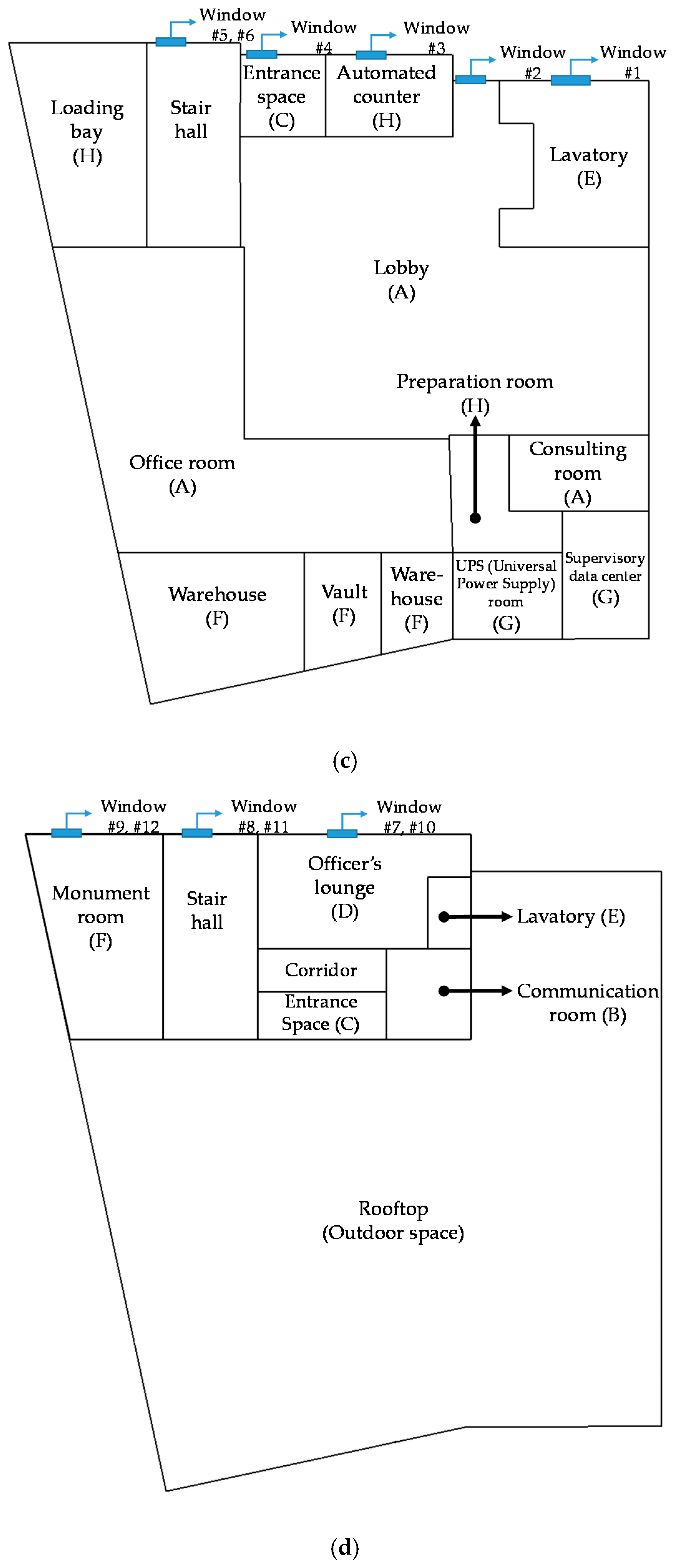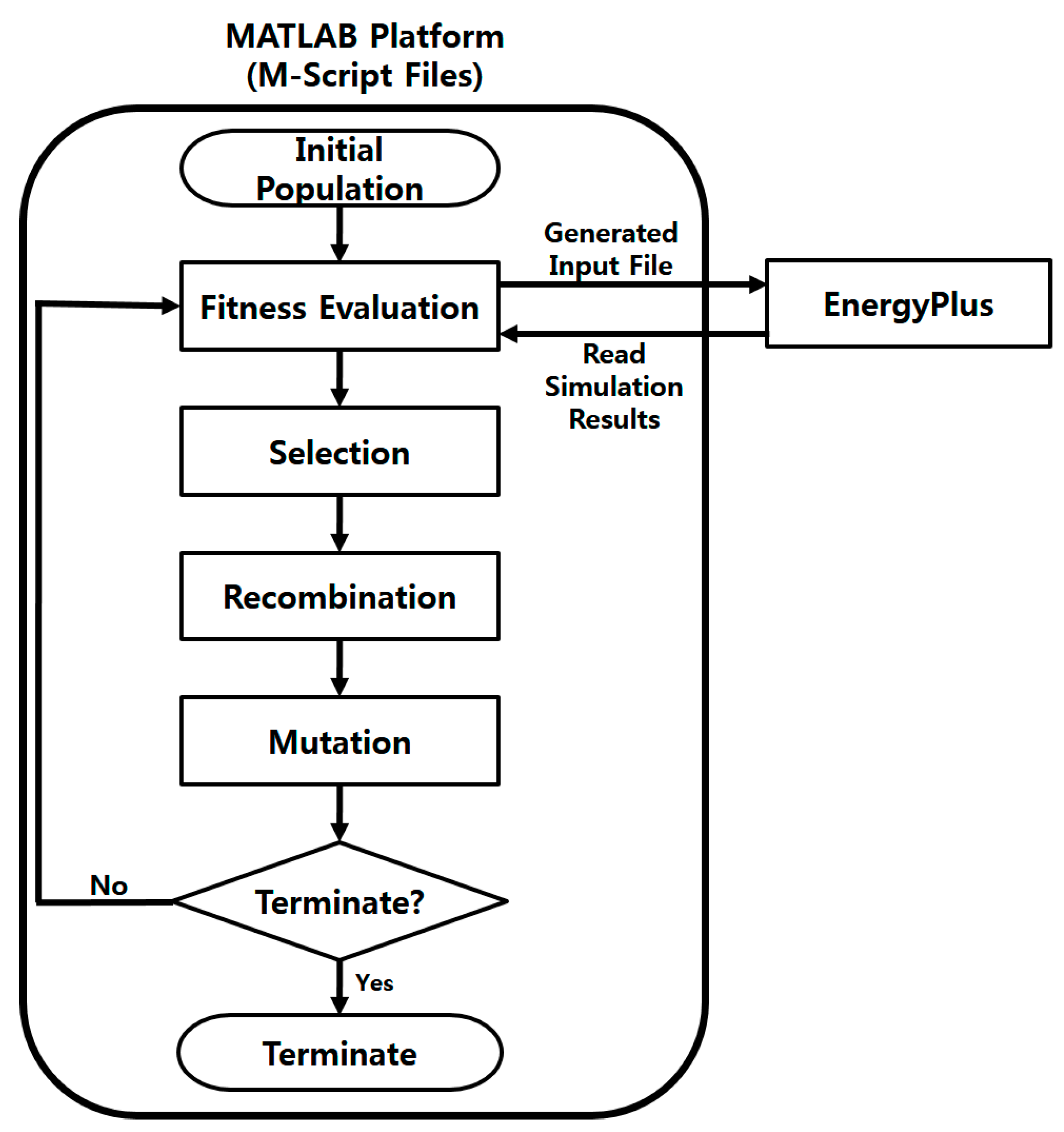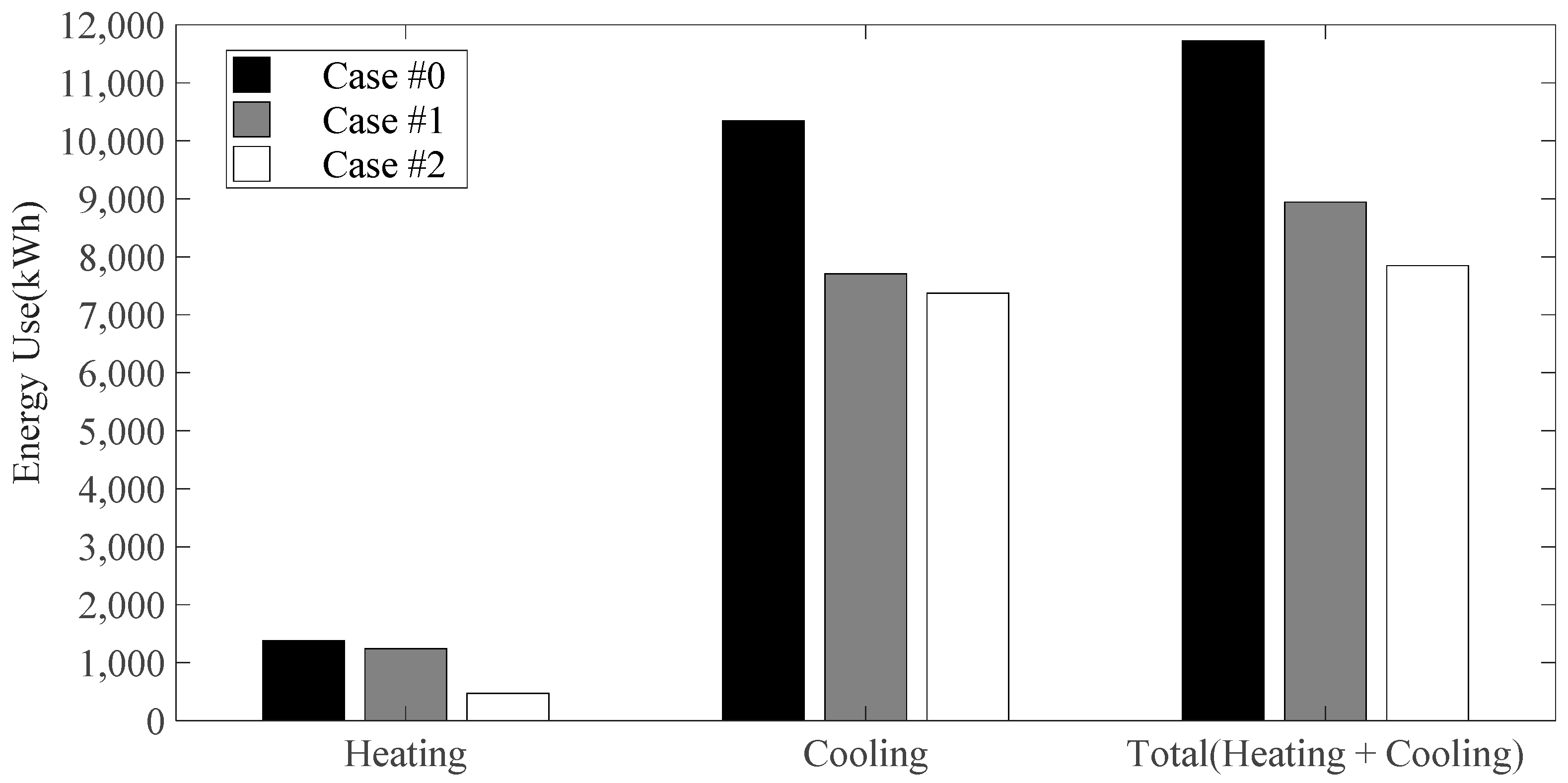Heuristic vs. Meta-Heuristic Optimal Energy Design for an Office Building
Abstract
:1. Introduction
2. Case Study
3. Three Optimization Cases
3.1. Case #1: Heuristic Approach
3.2. Case #2: Meta-Heuristic Approach by Genetic Algorithm (GA) Applied to a Constrained Search Space
3.3. Case #3: Meta-Heuristic Approach by Genetic Algorithm (GA) Applied to a Less Constrained Search Space (One More Option of a Design Variable)
- The list of design variables to be optimized is the same as in Case #2. In addition, it is assumed that the window–wall ratio of each window can be optimized ranging from 1% to 99%.
- The number of windows remains the same as that of the original design (Figure 1).
- The location of each window remains the same as that of the original design (Figure 1).
4. Implementation of GA Integrated to EnergyPlus
- Fitness evaluation: evaluate each individual using the given objective function. The value of the function is the fitness of each individual.
- Selection: two randomly-selected individuals participate in the selection operation to reproduce offspring. The higher fitness, the more chance to be selected.
- Recombination: mixing of values occurs between selected individuals.
- Mutation: a probabilistic bit-wise mutation proceeds, in which a given gene value is flipped from 0 to 1, or vice versa. A larger space is explored with this operation.
- Elitism: in this study, all other solutions except the top two solutions having the highest fitness were replaced. This guarantees that the search does not diverge from a solution having a higher objective function than that already found by the search.
5. Results
5.1. Case #0 (Original Design), Case #1 (Heuristic) vs. Case #2 (Meta-Heuristic Approach Applied to a Constrained Search Space)
- Case #2-1: minimum insulation thickness is applied to building envelopes (70 mm for walls in B1, 1F & 2F, 135 mm for roof). All other design variables are identical to those of Case #2.
- Case #2-2: maximum insulation thickness is applied to building envelopes (350 mm for walls in B1, 1F & 2F, 400 mm for roof). All other design variables are identical to those of Case #2.
- Case #2-3: triple low-e glazing is applied to all twelve windows. Please note that in Case #2, double low-e glazing was applied to three windows (Table 7). All other design variables are identical to those of Case #2.
5.2. Case #3 Meta-Heuristic Approach by Genetic Algorithm (GA) Applied to a Less Constrained Search Space
- Case #3-1: all blinds are located externally. All other design variables are identical to those of Case #3
- Case #3-2: triple low-e glazing is applied to 12 windows. All other design variables are identical to those of Case #3
6. Conclusions
Acknowledgments
Author Contributions
Conflicts of Interest
References
- Caldas, L.G.; Norford, L.K. A design optimization tool based on a genetic algorithm. Autom. Constr. 2002, 11, 173–184. [Google Scholar] [CrossRef]
- Pearl, J. Heuristics: Intelligent Search Strategies for Computer Problem Solving; Addison-Wesley: Reading, MA, USA, 1983. [Google Scholar]
- Caldas, L.; Norford, L.K.; Rocha, J. An evolutionary model for sustainable design. Manag. Environ. Qual. Int. J. 2003, 14, 383–397. [Google Scholar] [CrossRef]
- Coley, D.A.; Schukat, S. Low-Energy design: Combining computer-based optimisation and human judgment. Build. Environ. 2002, 37, 1241–1247. [Google Scholar] [CrossRef]
- Kampf, J.H.; Wetter, M.; Robinson, D. A comparison of global optimization algorithms with standard benchmark functions and real-world applications using EnergyPlus. J. Build. Perform. Simul. 2010, 3, 103–120. [Google Scholar] [CrossRef]
- Elbeltagi, E.; Hegazy, T.; Grierson, D. Comparison among five evolutionary-based optimization algorithms. Adv. Eng. Inform. 2005, 19, 43–53. [Google Scholar] [CrossRef]
- Hamdy, M.; Nguyen, A.-T.; Hensen, J. A performance comparison of multi-objective optimization algorithms for solving nearly-zero-energy-building design problems. Energy Build. 2016, 121, 57–71. [Google Scholar] [CrossRef]
- Nguyen, A.-T.; Reiter, S.; Rigo, P. A review on simulation-based optimization methods applied to building performance analysis. Appl. Energy 2014, 113, 1043–1058. [Google Scholar] [CrossRef]
- Banos, R.; Manzano-Agugliaro, F.; Montoya, F.G.; Gil, C.; Alcayde, A.; Gomez, J. Optimization methods applied to renewable and sustainable energy: A review. Renew. Sustain. Energy Rev. 2011, 15, 1753–1766. [Google Scholar] [CrossRef]
- Oh, S.M.; Kim, Y.J.; Park, C.S.; Kim, I.H. Process-Driven BIM-based optimal design using integration of EnergyPlus, genetic algorithm, and Pareto optimality. In Proceedings of the 12th Conference of International Building Performance Simulation Association, Sydney, Australia, 14–16 November 2011; pp. 894–901. [Google Scholar]
- Asadi, E.; de Silva, M.G.; Antunes, C.H.; Dias, L. A multi-objective optimization model for building retrofit strategies using TRNSYS simulations, GenOpt and MATLAB. Build. Environ. 2012, 56, 370–378. [Google Scholar] [CrossRef]
- Ihm, P.; Krarti, M. Design optimization of energy efficient residential buildings in Tunisia. Build. Environ. 2012, 58, 81–90. [Google Scholar] [CrossRef]
- Yao, J. Energy optimization of building design for different housing units in apartment buildings. Appl. Energy 2012, 94, 330–337. [Google Scholar] [CrossRef]
- Evins, R. A review of computational optimization methods applied to sustainable building design. Renew. Sustain. Energy Rev. 2013, 22, 230–245. [Google Scholar] [CrossRef]
- Attia, S.; Hamdy, M.; O’Brien, W.; Carlucci, S. Computational optimization for zero energy buildings design: Interviews results with twenty eight international experts. In Proceedings of the 13th Conference of International Building Performance Simulation Association, Chambery, France, 26–28 August 2013. [Google Scholar]
- Kim, Y.J.; Park, C.S. Multi-Criterion stochastic optimal selection of a double glazing system. Build. Simul. 2017, 10, 1–9. [Google Scholar] [CrossRef]
- Mitchell, M. An Introduction to Genetic Algorithm; The MIT Press: Cambridge, UK, 1997. [Google Scholar]
- Ooka, R.; Komamura, K. Optimal design method for building energy systems using genetic algorithms. Build. Environ. 2009, 44, 1538–1544. [Google Scholar] [CrossRef]
- Grefenstette, J. Optimization of control parameters for genetic algorithms. IEEE Trans. Syst. Man Cybern. 1986, 16, 122–128. [Google Scholar] [CrossRef]
- Back, T. Evolutionary Algorithms in Theory and Practice; Oxford University Press: Oxford, UK, 1996. [Google Scholar]
- Back, T.; Fogel, D.B.; Michalewicz, Z. Evolutionary Computation 2: Advanced Algorithms and Operators (Evolutionary Computation); IOP Publishing Ltd.: Bristol, UK, 1996. [Google Scholar]
- Deb, K.D. Multi-Objective Optimization Using Evolutionary Algorithms; John Wiley & Sons Inc.: New York, NY, USA, 2001. [Google Scholar]
- Wright, J.; Alajmi, A. The robustness of genetic algorithms in solving unconstrained building optimization problems. Proceedings the 9th Conference of International Building Performance Simulation Association, Montreal, QC, Canada, 15–18 August 2005; pp. 1361–1368. [Google Scholar]
- Wright, J.; Farmani, R. The simultaneous optimization of building fabric construction, HVAC system size, and the plant control strategy. Proceedings the 7th Conference of International Building Performance Simulation Association, Rio de Janeiro, Brazil, 13–15 August 2001; pp. 865–872. [Google Scholar]
- Palonen, M.; Hasan, A.; Siren, K. A genetic algorithm for optimization of building envelope and HVAC system parameters. Proceedings the 11th Conference of International Building Performance Simulation Association, Glasgow, Scotland, 27–30 July 2009; pp. 159–166. [Google Scholar]
- Baron, J. Thinking and Deciding, 3rd ed.; Cambridge University Press: New York, NY, USA, 2000. [Google Scholar]
- Tversky, A.; Kahneman, D. Judgments under Uncertainty: Heuristics and Biases. Science 1974, 185, 1124–1131. [Google Scholar] [CrossRef] [PubMed]
- Keohler, D.J.; Harvey, N. Blackwell Handbook of Judgment and Decision Making; Wiley-Blackwell: Oxford, UK, 2004. [Google Scholar]
- Mussweller, T.; Englich, B.; Strack, F. Cognitive Illusions: A Handbook on Fallacies and Biases in Thinking, Judgment and Memory; Psychology Press: New York, NY, USA, 2004; pp. 183–200. [Google Scholar]
- Kim, Y.J.; Ahn, K.U.; Park, C.S. Decision Making of HVAC System using Bayesian Markov Chain Monte Carlo method. Energy Build. 2014, 72, 112–121. [Google Scholar] [CrossRef]





| Room Category * | Operation Time | Minimum Outdoor Air (ACH) | Internal Equipment (W/m2) | Heating Setpoint (‘C) | Cooling Setpoint (‘C) |
|---|---|---|---|---|---|
| A | 09-18 | 0.7 | 12 | 20 | 26 |
| B | 00-24 | 0.4 | 30 | 22 | 26 |
| C | 09-18 | 1.0 | 3.1 | 20 | 26 |
| D | 09-18 | 1.25 | 10 | 20 | 26 |
| E | 09-18 | 0.7 | 3.1 | 20 | 26 |
| F | 09-18 | 0.4 | 5 | 20 | 26 |
| G | 00-24 | 0.4 | 25 | 20 | 26 |
| H | 09-18 | 1.25 | 10 | 22 | 26 |
| Design Variables | Value of the Original Design | |
|---|---|---|
| Insulation thickness and U-values of walls/roof | Walls in B1 | 250 mm (0.117 W/m2K) |
| Walls in 1F–2F | 250 mm (0.118 W/m2K) | |
| Roof | 300 mm (0.100 W/m2K) | |
| Blinds | not installed | |
| LED lights | not installed | |
| U-value of glazing | 0.91 W/m2K (glazing type is not specified) | |
| Design Variables | Value | |
|---|---|---|
| Insulation thickness and U-values of walls/roof | Walls in B1 | 250 mm (0.117 W/m2K) |
| Walls in 1F–2F | 250 mm (0.118 W/m2K) | |
| Roof | 300 mm (0.100 W/m2K) | |
| Blinds | External blinds to be installed to all windows | beam/diffuse/visible transmittance = 0.0 front/back beam/diffuse/visible reflectance = 0.5 front/back infrared emissivity = 0.9 slat conductivity = 0.9 (W/mK) |
| LED Lights | LED lights to be installed in two rooms requiring long burning hours per day | |
| Glazing | all glazing: triple low-e glazing (U-value: 0.774 W/m2K, g = 0.433, e = 0.1 on surfaces 2, 4) | |
| Design Variables | Range | Description | The Number of Design Options | |
|---|---|---|---|---|
| Insulation thickness (mm) | Walls in B1, 1F–2F | 70–350 | Increment of 10mm interval | 293 |
| Roof | 135–400 | 28 | ||
| Blinds | 0–2 | 0: No blinds 1: Internal blinds 2: External blinds | 312 | |
| LED lights | 0, 1 | 0: Not installed 1: Installed | 215 | |
| Glazing | 0–2 | 0: Triple low-e glazing (U = 0.774 W/m2K, g = 0.433, e = 0.1 on surfaces 2, 4) 1: Double Low-e glazing (U = 1.45 W/m2K, g = 0.571, e = 0.1 on surface 2) 2: Clear double glazing (U = 2.52 W/m2K, g = 0.719) | 312 | |
| Genetic Operator | Method | Parameter |
|---|---|---|
| Selection | Tournament selection | - |
| Recombination | Uniform crossover | An average of 50% of the bits are swapped |
| Mutation | Bit-wise mutation | 2% probability of mutation |
| Heating (kWh) | Cooling (kWh) | Total (kWh) | |
|---|---|---|---|
| Case #0 | 1378 (100%) | 10,345(100%) | 11,723 (100%) |
| Case #1 | 1240 (90%) | 7704 (74%) | 8944 (76%) |
| Case #2 | 471 (34%) | 7375 (71%) | 7847 (67%) |
| Design Variables | Value | |||
|---|---|---|---|---|
| Original Design (Case #0) | Heuristic (Case #1) | Meta-Heuristic (Case #2) | ||
| Insulation thickness (mm) | Walls in B1 | 250 mm | 250 mm | 130 mm |
| Walls in 1F | 250 mm | 250 mm | 310 mm | |
| Walls in 2F | 250 mm | 250 mm | 230 mm | |
| Roof | 300 mm | 300 mm | 385 mm | |
| Blinds | Not installed | All external blinds | All external blinds | |
| LED lights | Not installed | Installed in two rooms | Installed in all rooms | |
| Glazing in room # | 1 | Specified in terms of the U-calue of 0.91 W/m2K | Triple low-e glazing for all twelve windows | Double low-e glazing |
| 2 | Triple low-e glazing | |||
| 3 | Triple low-e glazing | |||
| 4 | Triple low-e glazing | |||
| 5 | Triple low-e glazing | |||
| 6 | Double low-e glazing | |||
| 7 | Triple low-e glazing | |||
| 8 | Triple low-e glazing | |||
| 9 | Double low-e glazing | |||
| 10 | Triple low-e glazing | |||
| 11 | Triple low-e glazing | |||
| 12 | Triple low-e glazing | |||
| Heating (kWh) | Cooling (kWh) | Total (kWh) | |
|---|---|---|---|
| Case #2 | 471 (100%) | 7375 (100%) | 7847 (100%) |
| Case #2-1 | 2306 (490%) | 6902 (94%) | 9208 (123%) |
| Case #2-2 | 601 (128%) | 7468 (101%) | 8069 (108%) |
| Case #2-3 | 578 (123%) | 7357 (99.76%) | 7935 (101%) |
| Heating (kWh) | Cooling (kWh) | Total (kWh) | |
|---|---|---|---|
| Case #2 | 471 (100%) | 7375 (100%) | 7847 (100%) |
| Case #3 | 419 (89%) | 6723 (92%) | 7142 (91%) |
| Design Variables | Case #2 | Case #3 | |||
|---|---|---|---|---|---|
| Insulation thickness (mm) | Walls in B1 | 130 mm | 100 mm | ||
| Walls in 1F | 310 mm | 330 mm | |||
| Walls in 2F | 230 mm | 320 mm | |||
| Roof | 385 mm | 350 mm | |||
| Location of Blinds | 1 | All external blinds | External blinds | ||
| 2 | blinds not installed | ||||
| 3 | blinds not installed | ||||
| 4 | External blinds | ||||
| 5 | blinds not installed | ||||
| 6 | External blinds | ||||
| 7 | External blinds | ||||
| 8 | External blinds | ||||
| 9 | External blinds | ||||
| 10 | External blinds | ||||
| 11 | External blinds | ||||
| 12 | External blinds | ||||
| LED lights | Installed in all rooms | Installed in all rooms | |||
| Type of Glazing | 1 | Double low-e | Triple low-e | ||
| 2 | Triple low-e | Double clear | |||
| 3 | Triple low-e | Double clear | |||
| 4 | Triple low-e | Triple low-e | |||
| 5 | Triple low-e | Triple low-e | |||
| 6 | Double low-e | Double low-e | |||
| 7 | Triple low-e | Triple low-e | |||
| 8 | Triple low-e | Double low-e | |||
| 9 | Double low-e | Triple low-e | |||
| 10 | Triple low-e | Double clear | |||
| 11 | Triple low-e | Double low-e | |||
| 12 | Triple low-e | Triple low-e | |||
| Window-Wall Ratio (WWR) and window area | WWR | Area (m2) | WWR | Area (m2) | |
| 1 | 11% | 1.90 | 1% | 0.17 | |
| 2 | 36% | 1.90 | 1% | 0.05 | |
| 3 | 38% | 5.40 | 3% | 0.41 | |
| 4 | 77% | 7.52 | 17% | 1.63 | |
| 5 | 34% | 4.32 | 1% | 0.10 | |
| 6 | 33% | 2.26 | 10% | 0.63 | |
| 7 | 15% | 3.66 | 8% | 1.90 | |
| 8 | 20% | 1.91 | 2% | 0.19 | |
| 9 | 24% | 3.83 | 1% | 0.14 | |
| 10 | 12% | 1.68 | 1% | 0.13 | |
| 11 | 17% | 1.12 | 2% | 0.12 | |
| 12 | 14% | 1.20 | 10% | 0.84 | |
| Heating (kWh) | Cooling (kWh) | Total (kWh) | |
|---|---|---|---|
| Case #3 | 419 (100%) | 6723 (100%) | 7142 (100%) |
| Case #3-1 | 478 (114%) | 6658 (99%) | 7135 (99.9%) |
| Case #3-2 | 492 (117%) | 6691 (99.5%) | 7183 (100.6%) |
© 2017 by the authors. Licensee MDPI, Basel, Switzerland. This article is an open access article distributed under the terms and conditions of the Creative Commons Attribution (CC BY) license (http://creativecommons.org/licenses/by/4.0/).
Share and Cite
Suh, W.-J.; Park, C.-S. Heuristic vs. Meta-Heuristic Optimal Energy Design for an Office Building. Sustainability 2017, 9, 508. https://doi.org/10.3390/su9040508
Suh W-J, Park C-S. Heuristic vs. Meta-Heuristic Optimal Energy Design for an Office Building. Sustainability. 2017; 9(4):508. https://doi.org/10.3390/su9040508
Chicago/Turabian StyleSuh, Won-Jun, and Cheol-Soo Park. 2017. "Heuristic vs. Meta-Heuristic Optimal Energy Design for an Office Building" Sustainability 9, no. 4: 508. https://doi.org/10.3390/su9040508





